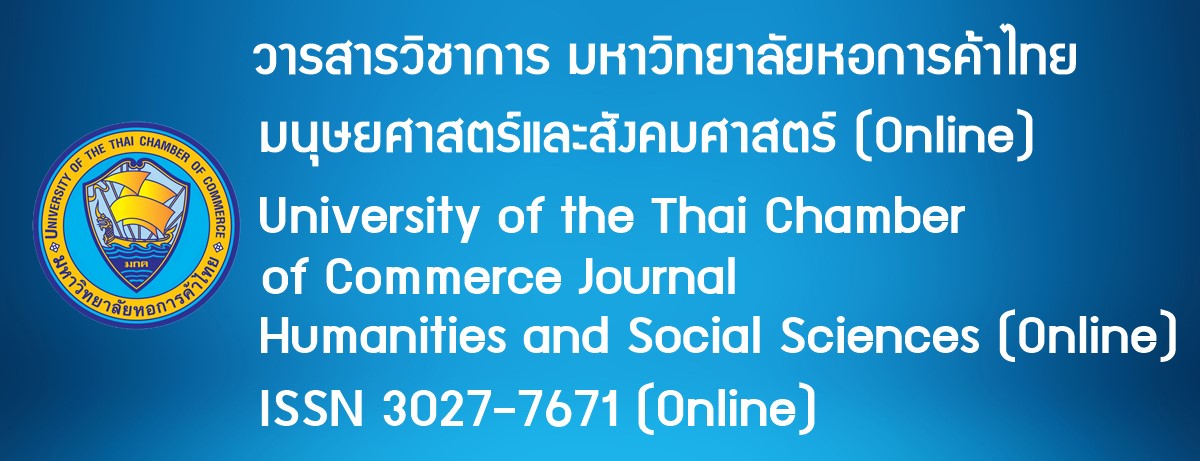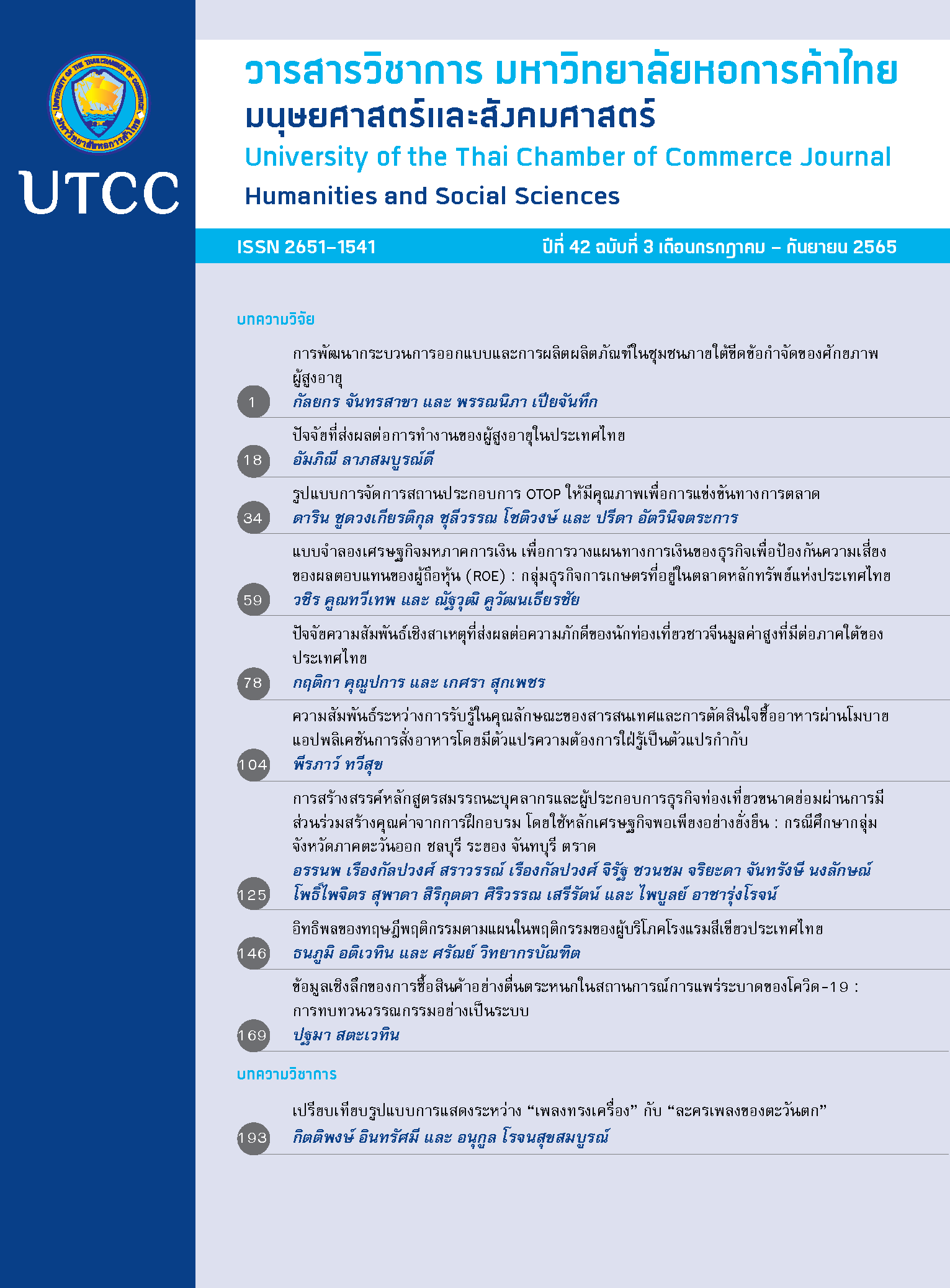ปัจจัยความสัมพันธ์เชิงสาเหตุที่ส่งผลต่อความภักดี ของนักท่องเที่ยวชาวจีนมูลค่าสูงที่มีต่อภาคใต้ ของประเทศไทย
Main Article Content
บทคัดย่อ
การวิจัยนี้เน้นถึงความภักดีของนักท่องเที่ยวชาวจีนมูลค่าสูง โดยมีวัตถุประสงค์เพื่อวิเคราะห์ปัจจัย ความสัมพันธ์เชิงสาเหตุระหว่างคุณภาพการบริการ ภาพลักษณ์แหล่งท่องเที่ยว ความพึงพอใจ คุณค่าที่รับรู้ ที่มีอิทธิพลต่อความภักดีปลายทางของนักท่องเที่ยวชาวจีนมูลค่าสูง โดยใช้แบบสอบถามเป็นเครื่องมือในการเก็บรวบรวมข้อมูลจากนักท่องเที่ยวชาวจีนมูลค่าสูงที่เคยเดินทางมาท่องเที่ยวในจังหวัดภูเก็ต กระบี่ และสุราษฎร์ธานี(เกาะสมุย) จำนวน 400 ชุด โดยใช้วิธีการสุ่มตัวอย่างแบบเจาะจง (Purposive Sampling) วิเคราะห์ข้อมูลโดยการวิเคราะห์โมเดลสมการโครงสร้าง ผลการศึกษา พบว่า โมเดลสมการโครงสร้างมีความสอดคล้องกลมกลืนกับข้อมูลเชิงประจักษ์ดีโดยมีค่า Chi–Square = 221.830 df = 195.0 Sig. = 0.091 >
0.05 CMIN/df. 1.138 < 2.0 GFI = 0.958 AGFI = 0.931 NFI = 0.974 IFI = 0.997 CFI = 0.997 RMR = 0.032
และ RMSEA = 0.020 อย่างมีนัยสำคัญทางสถิติที่ 0.05 ข้อค้นพบสำคัญที่ได้จากการวิจัยคือ ภาพลักษณ์ของ แหล่งท่องเที่ยวทางภาคใต้ของประเทศไทยมีอิทธิพลต่อความภักดีของแหล่งท่องเที่ยวของนักท่องเที่ยวชาวจีนมูลค่าสูงสูงสุดโดยส่งผ่านตัวแปรความพึงพอใจ ปัจจัยด้านการรับรู้คุณค่านั้นมีอิทธิพลเชิงบวกทางตรงต่อความภักดีต่อแหล่งท่องเที่ยวทางภาคใต้ ปัจจัยด้านคุณภาพการบริการมีอิทธิพลเชิงบวกทางอ้อมต่อความภักดีของแหล่งท่องเที่ยวโดยผ่านตัวแปรความพึงพอใจ และปัจจัยด้านความพึงพอใจนั้นมีอิทธิพลทางตรงต่อความภักดีของแหล่งท่องเที่ยวทางภาคใต้เช่นเดียวกัน จากผลการศึกษาที่ได้นั้น ผู้มีส่วนเกี่ยวข้องไม่ว่าจะเป็นภาครัฐผู้ประกอบการ และสถาบันการศึกษาสามารถนำไปเป็นแนวทางในการพัฒนาการปัจจัยที่ส่งผลต่อความภักดีของนักท่องเที่ยวมูลค่าสูง เพื่อเพิ่มศักยภาพในการแข่งขันให้แก่ภาคใต้
Article Details

This work is licensed under a Creative Commons Attribution-NonCommercial-NoDerivatives 4.0 International License.
ลิขสิทธิ์ของบทความ
ผลงานที่ได้รับการตีพิมพ์ถือเป็นลิขสิทธิ์ของมหาวิทยาลัยหอการค้าไทย ห้ามมิให้นำเนื้อหา ทัศนะ หรือข้อคิดเห็นใด ๆ ของผลงานไปทำซ้ำ ดัดแปลง หรือเผยแพร่ ไม่ว่าทั้งหมดหรือบางส่วนโดยไม่ได้รับอนุญาตเป็นลายลักษณ์อักษรจากมหาวิทยาลัยหอการค้าไทยก่อน
References
การท่องเที่ยวแห่งประเทศไทย. (2558). รายงานสรุปฉบับผู้บริหาร โครงการศึกษาตลาดนักท่องเที่ยวศักยภาพสูงจีน อินเดีย รัสเซีย. สืบค้นจาก https://issuu.com/etatjournal/docs/china-india-russia_high_potential
การท่องเที่ยวแห่งประเทศไทย, ศูนย์วิจัยด้านการตลาดท่องเที่ยว. (2562). 7 จังหวัดของไทย ที่นักท่องเที่ยวจีนไปมากสุดในปี2018.สืบค้นเมื่อ14 มกราคม 2565,จากhttps://intelligencecenter.tat.or.th/articles/15233
เกศรา สุกเพชร, และโชคชัย สุเวชวัฒนกูล. (2557). กลยุทธ์การจัดการโซ่อุปทานการท่องเที่ยวไทยเพื่อการรองรับนักท่องเที่ยวจีนกลุ่มคุณภาพ. กรุงเทพฯ: สถาบันบัณฑิตพัฒนบริหารศาสตร์, ศูนย์ศึกษาการจัดการการท่องเที่ยวแบบบูรณาการ.
ธมยันตี ประยูรพันธ์. (2561). การทดสอบโมเดลสมการโครงสร้างความพึงพอใจในการปฏิบัติงานพฤติกรรมการเป็นสมาชิกที่ดีขององค์กรและพฤติกรรมการทำงานเชิงนวัตกรรมของพนักงานองค์กร วิสาหกิจขนาดกลาง และขนาดย ่อมในจังหวัดชายแดนใต้. วารสารมหาวิทยาลัยนราธิวาสราชนครินทร์
สาขามนุษยศาสตร์และสังคมศาสตร์, 5(2), 55-73. สืบค้นจาก https://so05.tci-thaijo.org/index.php/pnuhuso/article/view/115954
มรกต กำแพงเพชร, แววมยุรา คำสุข, ณภัทร ศรีนวล, และสุชารัตน์กู้เกียรติสกุลมั่น. (2559). ปัจจัยที่มีอิทธิพลต่อความภักดีของนักท่องเที่ยวชาวจีนต่อแหล่งท่องเที่ยวในกลุ่มจังหวัดภาคตะวันออกของประเทศไทย,วารสารธุรกิจปริทัศน์, 8(1), 137-154. สืบค้นจาก https://so01.tci-thaijo.org/index.php/bahcuojs/article/view/129759
สำนักงานคณะกรรมการพัฒนาการเศรษฐกิจและสังคมแห่งชาติ. (2561). ยุทธศาสตร์ชาติ พ.ศ. 2561- 2580 (ฉบับย่อ).สืบค้นจากhttps://www.nesdc.go.th/download/document/SAC/NS_SumPlanOct2018.pdf
Agrawal, R., Gaur, S. S., & Narayanan, A. (2012). Determining customer loyalty: Review and model.The Marketing Review, 12(3), 275-289. Retrieved from www.academia.edu/12680285/Determining_customer_loyalty_Review_and_model
Bagozzi, R. P., & Yi, Y. (1988). On the evaluation of structural equation models. Journal of the Academy of Marketing Science, 16(1), 74-94. doi: 10.1007/BF02723327
Chang, H. M., & Lin, C. H. (2020). Island tourism: Participation behavior of tourists. Social Behavior and Personality: An International Journal, 48(5), 1-11. doi: 10.2224/sbp.8597
Chegini, M. G. (2010). Customer loyalty and value key dimensions interaction in organization. China-USA Business Review, 9(8), 8-14.
Chen, C. F., & Chen, F. S. (2010). Experience quality, perceived value, satisfaction and behavioralintentions for heritage tourists. Tourism Management, 31(1), 29-35.
Ctrip and China Tourism Academy. (2018). 2017 China outbound tourism travel report. Retrieved January 14, 2021, from https://www.scribd.com/document/436237489/2017-China- Outbound-Tourism-Travel-Report
Diamantopoulos, A., & Siguaw, J. A. (2006). Formative versus reflective indicators in organizational measure development: A comparison and empirical illustration. British Journal of Management, 17(4), 263-282.
Durande-Moreau, A., & Usunier, J. (1999). Time styles and the waiting experience: An exploratory study. Journal of Service Research, 2(2), 173-186.
Field, A. (2009). Discovering statistics using SPSS (3rd ed.). Los Angeles, CA: Sage Publications. Gefen, D., Karahanna, E., & Straub, D. W. (2003). Trust and TAM in online shopping: An integrated model. MIS Quarterly, 27(1), 51-90.
Hair, J. F., Black, B., Black, W. C., Babin, B. J., & Anderson, R. E. (2010). Multivariate data analysis (7th ed.). London: Pearson Education.
Kim, S. H., Holland, S., & Han, H. S. (2013). A structural model for examining how destination image, perceived value, and service quality affect destination loyalty: A case study of Orlando. International Journal of Tourism Research, 15(4), 313-328.
Lee, J. W., & Syah, A. M. (2018). Economic and environmental impacts of mass tourism on regional tourism destinations in Indonesia. Journal of Asian Finance, Economics and Business, 5(3), 31-41.
Lee, S., Jeon, S., & Kim, D. (2011). The impact of tour quality and tourist satisfaction on tourist loyalty: The case of Chinese tourists in Korea. Tourism Management, 32(5), 1115-1124.
Losada, N., & Mota, G. (2019). Slow down, your movie is too fast: slow tourism representations in the promotional videos of the Douro region (Northern Portugal), Journal of Destination Marketing & Management, 11, 140-149.
Lu, C. S., Weng, H.-K., Chen, C. W., Ma, H. Y., Mak, K. W., Yeung, T. C., & Chen S.-Y. (2020). How port aesthetics affect destination image, tourist satisfaction and tourist loyalty?. Maritime Business Review, 5(2), 211-228.
Luo, J., Dey, B. L., Yalkin, C., Sivarajah, U., Punjaisri, K., Huang, Y. A., & Yen, D. A. (2020). Millennial Chinese consumers’ perceived destination brand value. Journal of Business Research, 116, 655-665.
McDowall, S., & Ma, E. (2010). An analysis of tourists’ evaluation of Bangkok’s performance, their satisfaction, and destination loyalty: Comparing international versus domestic Thai tourists. Journal of Quality Assurance in Hospitality & Tourism, 11(4), 260-282.
The Nordics. (2018). Chinese market segment: High spending FITs opportunities and challenges for Nordic destinations. Retrieved from http://www.tourismstat.gl/resources/reports/en/r23/ Chinese_Market_Opportunities_and_Challenges_07082018.pdf
Parasuraman, A. P., Zeithaml, V. A., & Berry, L. L. (1985). A conceptual model of service quality and its implications for future research. The Journal of Marketing, 49, 41-50.
Prayogo, D., Cheng, M. Y., & Prayogo, H. (2017). A novel implementation of nature-inspired optimization for civil engineering: a comparative study of symbiotic organisms search. Civil Engineering Dimension, 19(1), 36-43.
Ramseook-Munhurrun, P., Seebaluck,V. N., & Naidoo, P. (2015).Examiningthestructural relationships of destination image, perceived value, tourist satisfaction and loyalty: case of Mauritius. Procedia-Social and Behavioral Sciences, 175, 252-259.
Sun, X., Geng-Qing Chi, C., & Xu, H. (2013). Developing destination loyalty: The case of Hainan Island. Annals of Tourism Research, 43, 547-577.
Sweeney, J. C., & Soutar, G. N. (2001). Consumer perceived value: The development of a multiple item scale. Journal of retailing, 77(2), 203-220.
Tinakhat, P. (2020). A study of tourist motivation toward destination loyalty: Targeting European tourists travelling to Phuket. Thammasat Review, 23(2), 22-46. Retrieved from https://sc01.tci-thaijo.org/index.php/tureview/article/view/235361
Tourism Research Australia. (2015). High – spending Asian leisure visitors. Retrived from https://www.tra.gov.au/ArticleDocuments/185/High_Spending_Asian_Leisure_Visitors_22072015_FINAL.pdf.aspx
Wen, J., Kozak, M., Yang, S., & Liu, F. (2020). COVID-19: potential effects on Chinese citizens’ lifestyle and travel. Tourism Review, 76(1), 74-87. doi: 10.1108/TR-03-2020-0110.
Wu, C. Y. (2016). Tourist behavioral intentions and festival quality: The case of Kaohsiung’s Lantern Festival. International Journal of Research in Tourism and Hospitality (IJRTH), 2(3), 23-28.
Zhang, H., Fu, X., Cai, L. A., & Lu, L. (2014). Destination image and tourist loyalty: A meta-analysis. Tourism Management, 40, 213-223.
Zineldin, M. (2000). Total relationship management (TRM) and total quality management (TQM). Managerial Auditing Journal, 15(1/2), 20-28.

